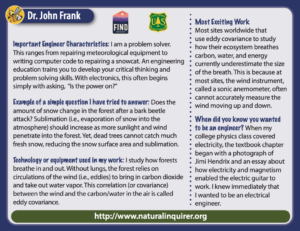Water
Learn more about watersheds, freshwater, the water cycle, water pollution, and more with a variety of Natural Inquirer resources. Browse by topic, grade band, and resource type.
-

 WaterWeather & Climate
WaterWeather & ClimateErika Cohen, Physical Scientist

- M.S., University of Mississippi
- USDA Forest Service Scientist
- A geographic information system (GIS) is a computer system that can capture, store, analyze, manage and display geographic data. A GIS professional uses the computer system to perform spatial analyses on geographic data to answer scientific questions and present the results in maps.
- M.S., University of Mississippi
- USDA Forest Service Scientist
- A geographic information system (GIS) is a computer system that can capture, store, analyze, manage and display geographic data. A GIS professional uses the computer system to perform spatial analyses on geographic data to answer scientific questions and present the results in maps.
-

 LandformsWaterWeather & Climate
LandformsWaterWeather & ClimateKarl Birkeland, Physical Geographer, “Avalanche Scientist”

- Ph.D., Arizona State University
- USDA Forest Service Scientist
- Avalanche scientists study all aspects of snow and avalanches. My specialty involves looking at how the snowpack on slopes varies and changes over time.
- Ph.D., Arizona State University
- USDA Forest Service Scientist
- Avalanche scientists study all aspects of snow and avalanches. My specialty involves looking at how the snowpack on slopes varies and changes over time.
-

 LandformsWater
LandformsWaterRuby Johnson, Mining Engineer

- B.S., Virginia Tech
- USDA Forest Service Scientist
- As a mining engineer, I am responsible for mine design, safety, earth-moving equipment, calculations, and developing plans that are economical and time-efficient. Mining engineers compile data from geology, hydrology, and other factors related to mine development and production.
- B.S., Virginia Tech
- USDA Forest Service Scientist
- As a mining engineer, I am responsible for mine design, safety, earth-moving equipment, calculations, and developing plans that are economical and time-efficient. Mining engineers compile data from geology, hydrology, and other factors related to mine development and production.
-

 Forests & PlantsWeather & Climate
Forests & PlantsWeather & ClimateJohn Frank, Electronics Engineer

- Ph.D., University of Wyoming
- USDA Forest Service Scientist
- An electronics engineer in the Forest Service usees math, physics and computers to design circuits, write programs, and build instruments to answer questions about how our forests function.
- Ph.D., University of Wyoming
- USDA Forest Service Scientist
- An electronics engineer in the Forest Service usees math, physics and computers to design circuits, write programs, and build instruments to answer questions about how our forests function.
-

 WaterWildlife
WaterWildlifeLeslie J. Boak, Construction Engineer

- B.S., Oregon State University
- USDA Forest Service Scientist
- A construction engineer is responsible for making sure all of the world’s infrastructures (e.g. the roads you drive on, the buildings that you go to school in, the systems that supply the water you drink) are built safely and correctly.
- B.S., Oregon State University
- USDA Forest Service Scientist
- A construction engineer is responsible for making sure all of the world’s infrastructures (e.g. the roads you drive on, the buildings that you go to school in, the systems that supply the water you drink) are built safely and correctly.
-

 LandformsSoilWater
LandformsSoilWaterMichael Balen – Civil, Mining, & Geological Engineer

- B.S. University of Alaska, Fairbanks
- USDA Forest Service Scientist
- As a Forest Service engineer, I manage the built environment, including the roads, bridges, and facilities, that connect people to the national forest landscape and enable Forest Service employees to do their jobs.
- B.S. University of Alaska, Fairbanks
- USDA Forest Service Scientist
- As a Forest Service engineer, I manage the built environment, including the roads, bridges, and facilities, that connect people to the national forest landscape and enable Forest Service employees to do their jobs.
-

 WaterWildlife
WaterWildlifeSusie Adams, Aquatic Ecologist & Astacologist

- Ph.D., The University of Montana
- USDA Forest Service Scientist
- An aquatic ecologist studies interactions in aquatic ecosystems, and an astacologist studies crayfish. I often focus on interactions involving fish and crayfish.
- Ph.D., The University of Montana
- USDA Forest Service Scientist
- An aquatic ecologist studies interactions in aquatic ecosystems, and an astacologist studies crayfish. I often focus on interactions involving fish and crayfish.

















